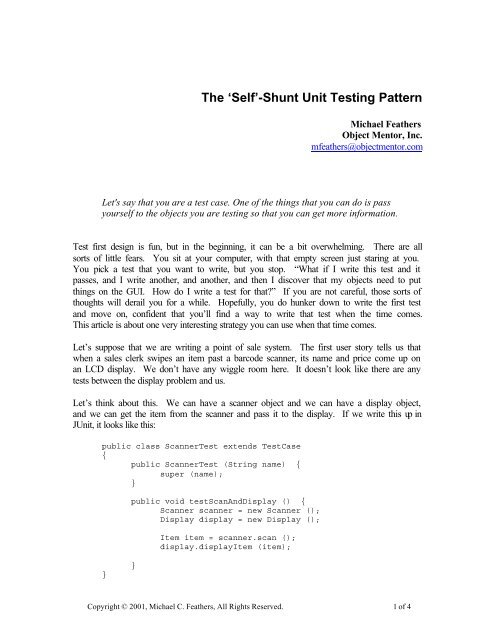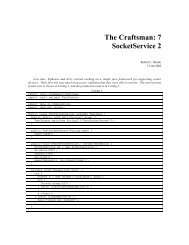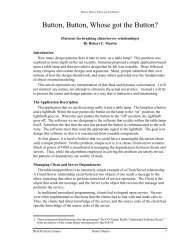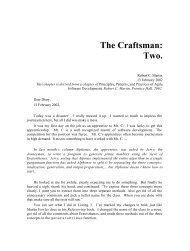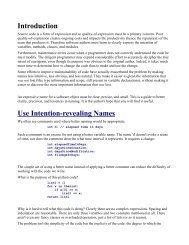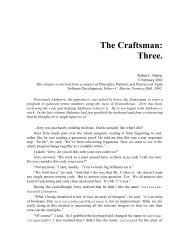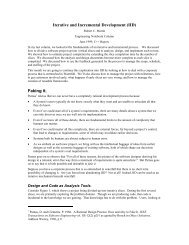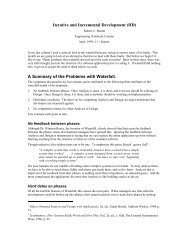The 'Self'-Shunt Unit Testing Pattern - Object Mentor
The 'Self'-Shunt Unit Testing Pattern - Object Mentor
The 'Self'-Shunt Unit Testing Pattern - Object Mentor
You also want an ePaper? Increase the reach of your titles
YUMPU automatically turns print PDFs into web optimized ePapers that Google loves.
act like a displaypublic class ScannerTest extends TestCase implements Display{public ScannerTest (String name) {super (name);}public void testScan () {// pass self as a displayScanner scanner = new Scanner (this);// scan calls displayItem on its displayscanner.scan ();}assertEquals (new Item (“Cornflakes”), lastItem);// impl. of Display.displayItem ()void displayItem (Item item) {lastItem = item;}}private Item lastItem;And that’s the ‘self’-shunt unit testing pattern. When a test case can impersonate one ofyour collaborators, it can check things that only a collaborator would know.‘Self’-shunt is a nice way to start a class when you need collaborators immediately, butoften it is just a stepping-stone. ‘Self’-shunting test cases can become unwieldy, as theyget larger. At that point, normal refactoring rules apply. With an interface like Displayin place, you can factor out a Mock <strong>Object</strong> [1], or even use a real object as it isdeveloped, provided it sets up easily and allows you decent coverage.History:‘Self’-shunt is one of those techniques that many people have discovered independently.I remember an XP Immersion class where at least two people jumped up and down andsaid “Hey, I’ve done that.” when Robert Martin described it on a flip chart. Kent Becksaid he’d been doing it for years, but I don’t remember him jumping.In any case, three uses make it a pattern. Me? I’ve been using it for a long time, but Ihave no idea whether I re-discovered it or heard about it somewhere.Copyright © 2001, Michael C. Feathers, All Rights Reserved. 3 of 4
Naming:<strong>The</strong> name ‘Self’-shunt is really a ‘tip of the hat’ to the <strong>Shunt</strong> <strong>Pattern</strong> [2], where AlistairCockburn describes a testing shunt as:“…basically a wire that goes out the back of one jack, and into aninput, so the machine is connected to itself. When you run themachine, it thinks it is connected to the world, but it is only talkingto itself. In software, the trick is to fake communication against theoutside world, then run the tests locally. <strong>The</strong>n your testing ispartitioned.”A ‘Self’-shunt is a shunt made by passing yourself to another object.References:[1] Tim MacKinnon, Steve Freeman, Philip Craig, Endo-<strong>Testing</strong>: <strong>Unit</strong> <strong>Testing</strong> withMock <strong>Object</strong>s. eXtreme Programming and Flexible Processes in SoftwareEngineering (XP2000)[2] Anonymous. <strong>Shunt</strong> <strong>Pattern</strong>. Portland <strong>Pattern</strong> Repository. Dec 12, 2000.http://c2.com/cgi/wiki?<strong>Shunt</strong><strong>Pattern</strong>Copyright © 2001, Michael C. Feathers, All Rights Reserved. 4 of 4


